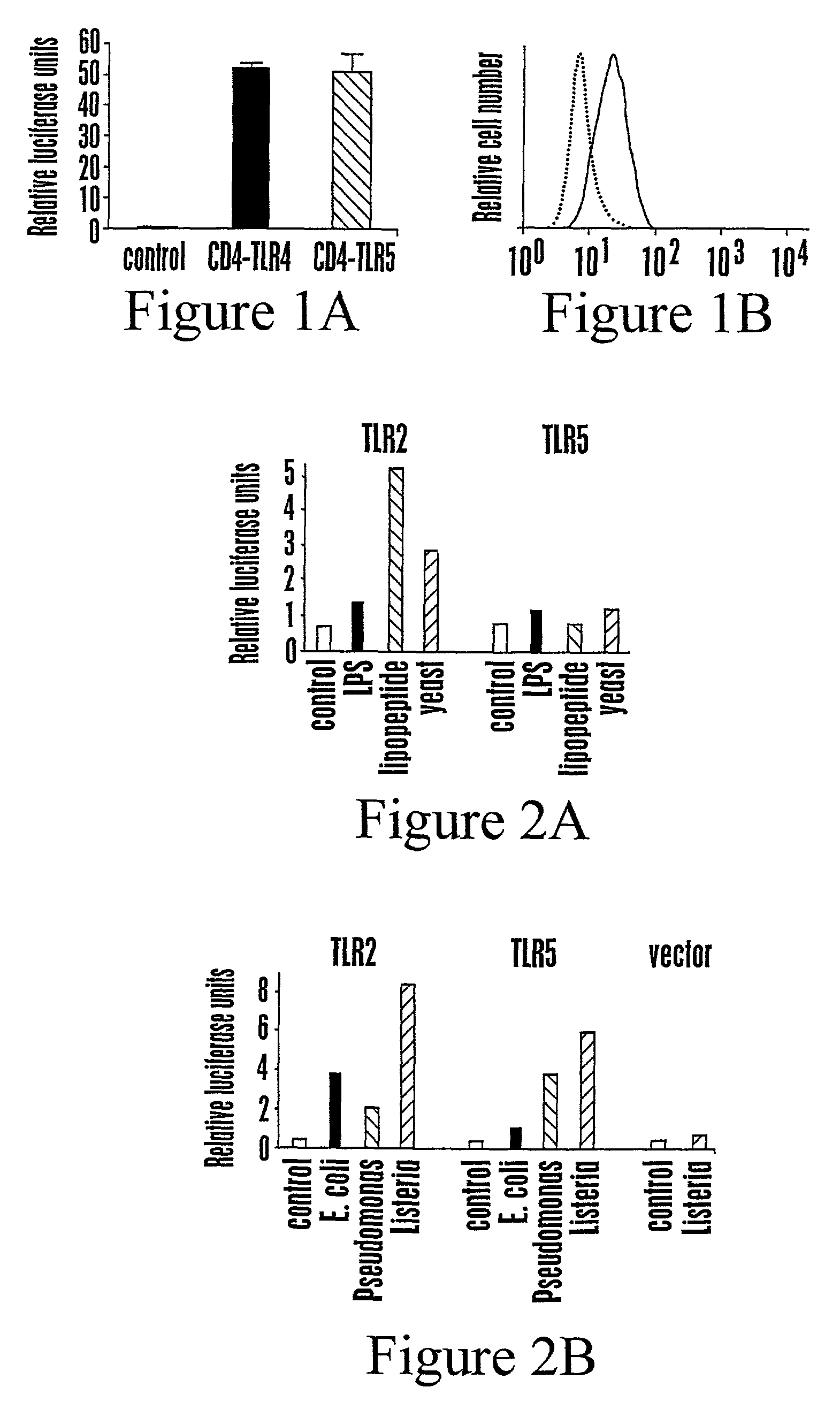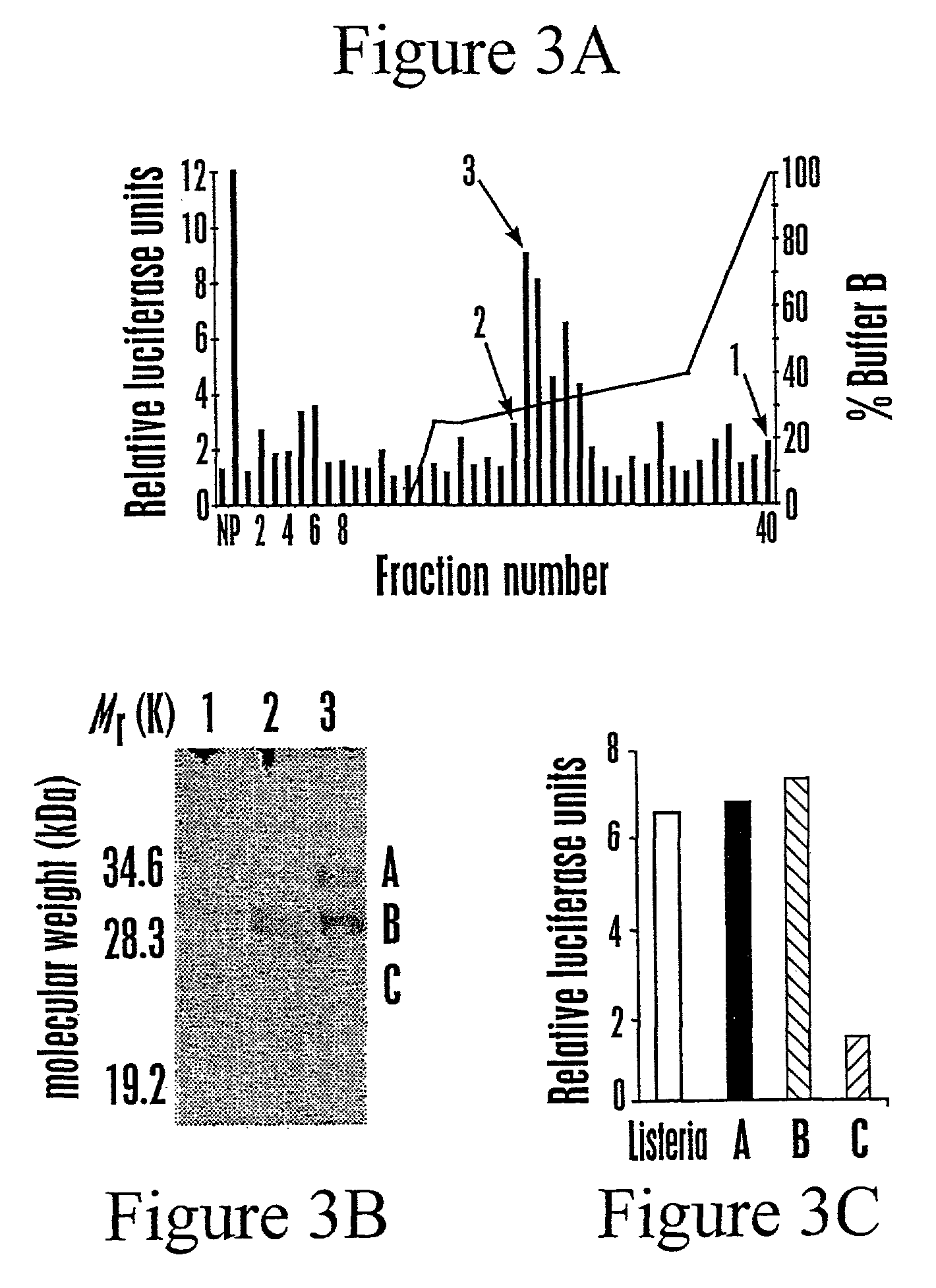Toll-like receptor 5 ligands and methods of use
a technology of toll-like receptor and ligand, which is applied in the direction of peptides, drug compositions, immunological disorders, etc., can solve the problems of unresponsive to the growth of tumors, unusual or abnormal proteins that alter normal cellular functions, and vaccines are ineffective in the absence of an adjuvan
- Summary
- Abstract
- Description
- Claims
- Application Information
AI Technical Summary
Benefits of technology
Problems solved by technology
Method used
Image
Examples
example i
Constitutively Active TLR5 Activates NF-κB and TNFα Production
[0135]This example shows activation of NF-κB and TNFα production in CHO cells in response to constitutively active TLR5.
[0136]To determine if TLR5 activates NF-κB and TNFα production, the activity of a constitutively active form of TLR5 was examined in CHO cells. Constitutively active forms of TLR4 and TLR5 were generated by fusing the extracellular domain of CD4 to the transmembrane and TIR domain of TLR4 or TLR5 (Medzihitov, R. et al. Nature 388, 394-7 (1997); Ozinsky, A. et al., Proc. Natl. Acad. Sci. 97, 13766-13881 (2000)). CD4-TLR5 was constructed by fusing the murine CD4 extracellular domain (amino acids 1-391) to the putative transmembrane and cytoplasmic domains of human TLR5 (amino acids 639-859) and cloning into pEF6-TOPO (pEF6-mCD4-hTLR5). These chimeras, referred to as CD4-TLR4 and CD4-TLR5 were expressed in CHO cells.
[0137]For determining NF-κB activity in response to TLR5, CHO cells were transiently transfe...
example ii
Bacterial Culture Supernatants Contain TLR5-Stimulating Activity
[0141]This Example shows that bacterial culture supernatants contain TLR5-stimulating activity.
[0142]CHO cells expressing human TLR5 and a luciferase-linked reporter were used to screen for PAMPs recognized by the receptor. PAMPS tested included LPS, lipopeptide, yeast, and extracts from E.coli, Pseudomonas, and Listeria. CHO cells were transiently transfected with TLR2, TLR5, or empty expression vectors together with a NF-κB luciferase reporter. The cells were treated with 100 ng / ml LPS, 100 ng / ml lipopeptide, 107 yeast particles / ml, or untreated (control), and luciferase activity was measured. The cells were treated with 67 μg / ml of supernatant from the indicated saturated bacterial cultures, or LB alone (control), and the luciferase activity was measured. Data are representative of 3 independent experiments.
[0143]Human TLR5 and TLR2 were generated by PCR from cDNA derived from human peripheral blood mononuclear cells...
example iii
Purification of TLR5-Stimulating Activity from L. monocytogenes Culture Supernatant
[0148]This Example shows the purification of TLR5-simulating activity from L. monocytogenes culture supernatant.
[0149]The biological activity recognized by TLR5 was determined to be TCA precipitable, phenol soluble, and sensitive to proteinase K and trypsin digestion. To identify the bacterial components that stimulate TLR5, the supernatant from a saturated L. monocytogenes culture was concentrated, fractionated by reverse-phase chromatography, and each fraction was assessed for TLR5-stimulating activity in CHO cells (FIG. 3a).
[0150]For assessing the TLR-stimulating activity of FPLC fractions, CHO cells were transfected as described in Example I with the addition of 0.1 μg of pNeo / Tak (Underhill et al., Nature 401, 811-5 (1999)), and stable populations of cells expressing the indicated TLR with the luciferase reporters were selected in 100 μg / ml G418. These cells were plated on 96-well plates at 100,0...
PUM
| Property | Measurement | Unit |
|---|---|---|
| volume | aaaaa | aaaaa |
| internal diameter | aaaaa | aaaaa |
| NF-κβ activity | aaaaa | aaaaa |
Abstract
Description
Claims
Application Information
 Login to View More
Login to View More - R&D
- Intellectual Property
- Life Sciences
- Materials
- Tech Scout
- Unparalleled Data Quality
- Higher Quality Content
- 60% Fewer Hallucinations
Browse by: Latest US Patents, China's latest patents, Technical Efficacy Thesaurus, Application Domain, Technology Topic, Popular Technical Reports.
© 2025 PatSnap. All rights reserved.Legal|Privacy policy|Modern Slavery Act Transparency Statement|Sitemap|About US| Contact US: help@patsnap.com



